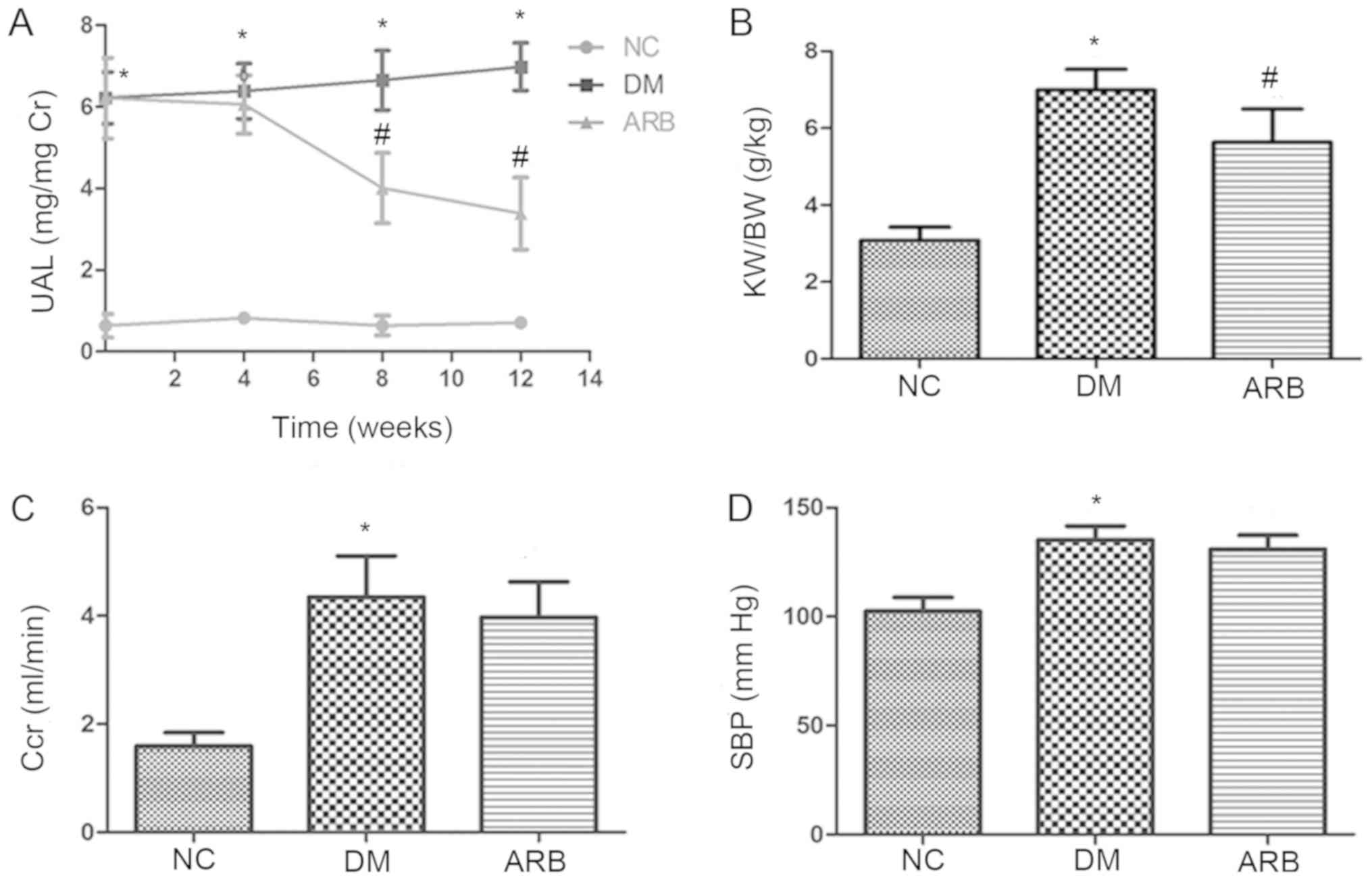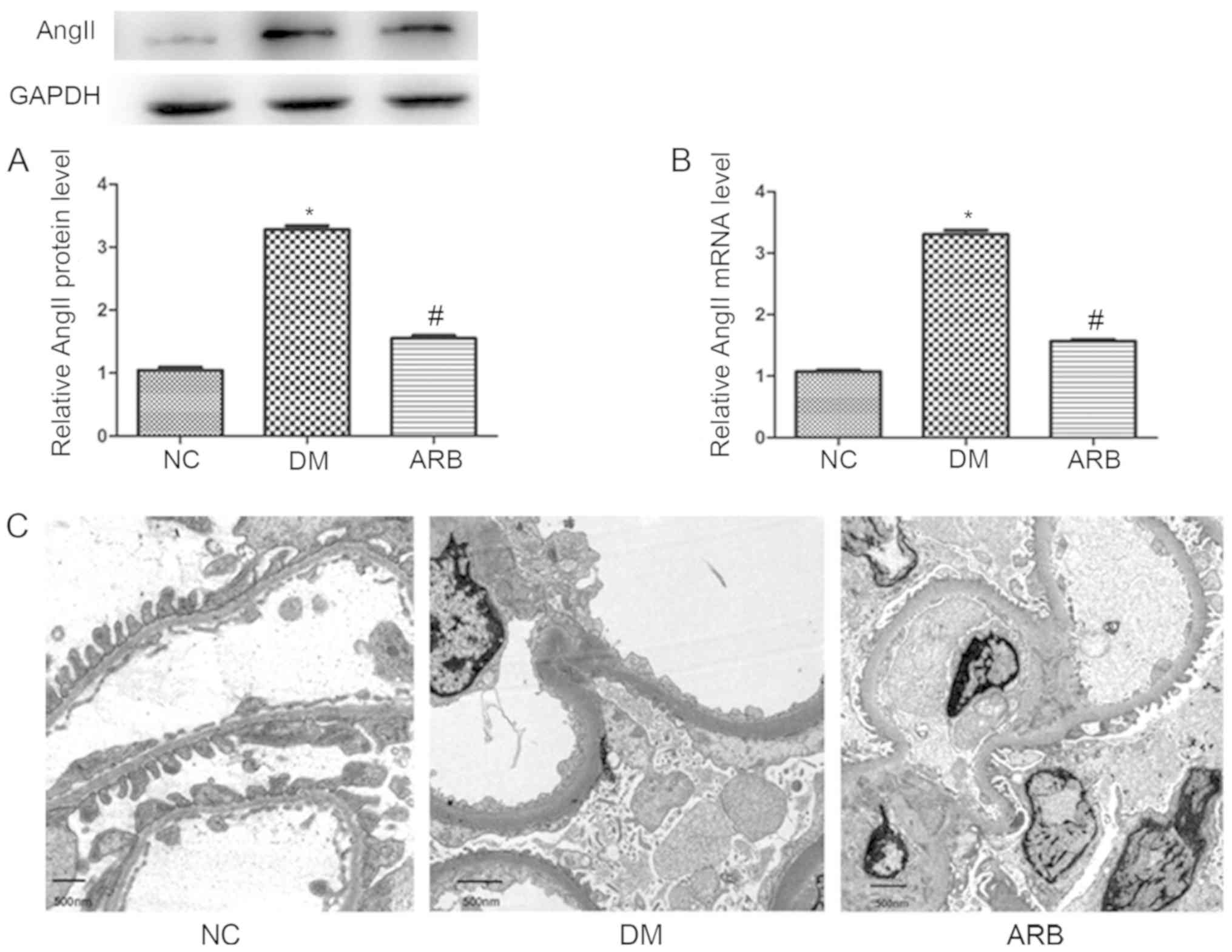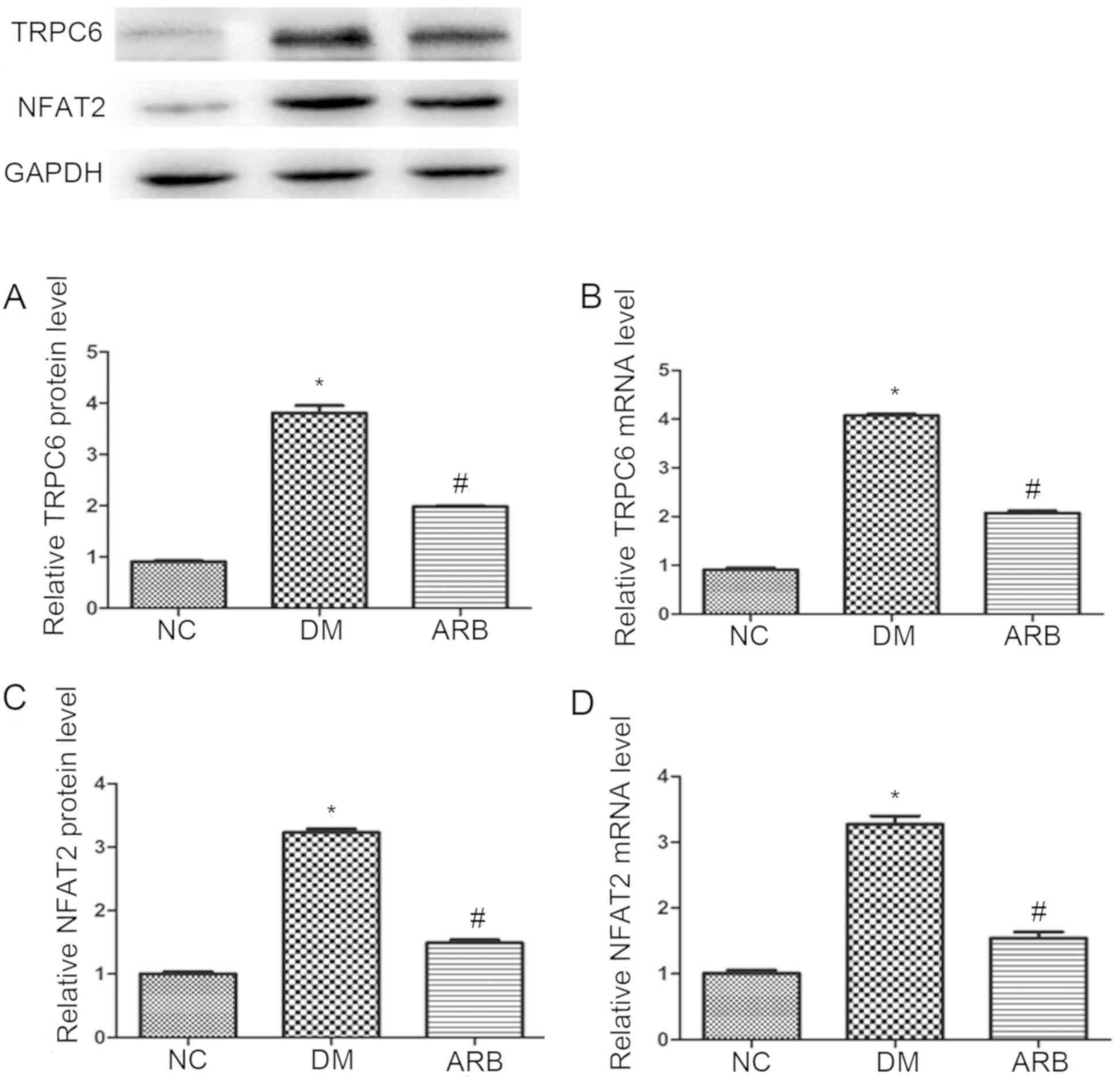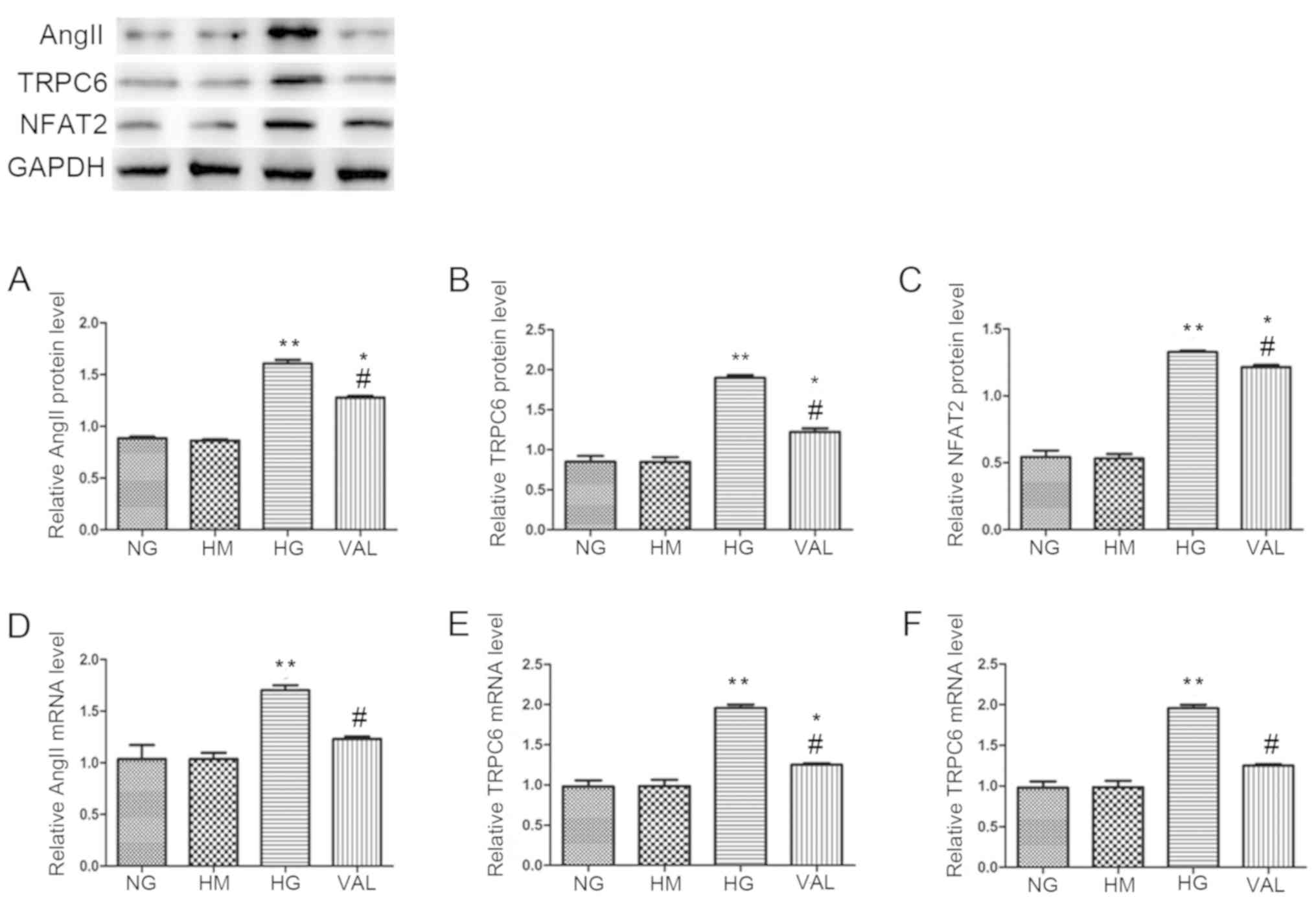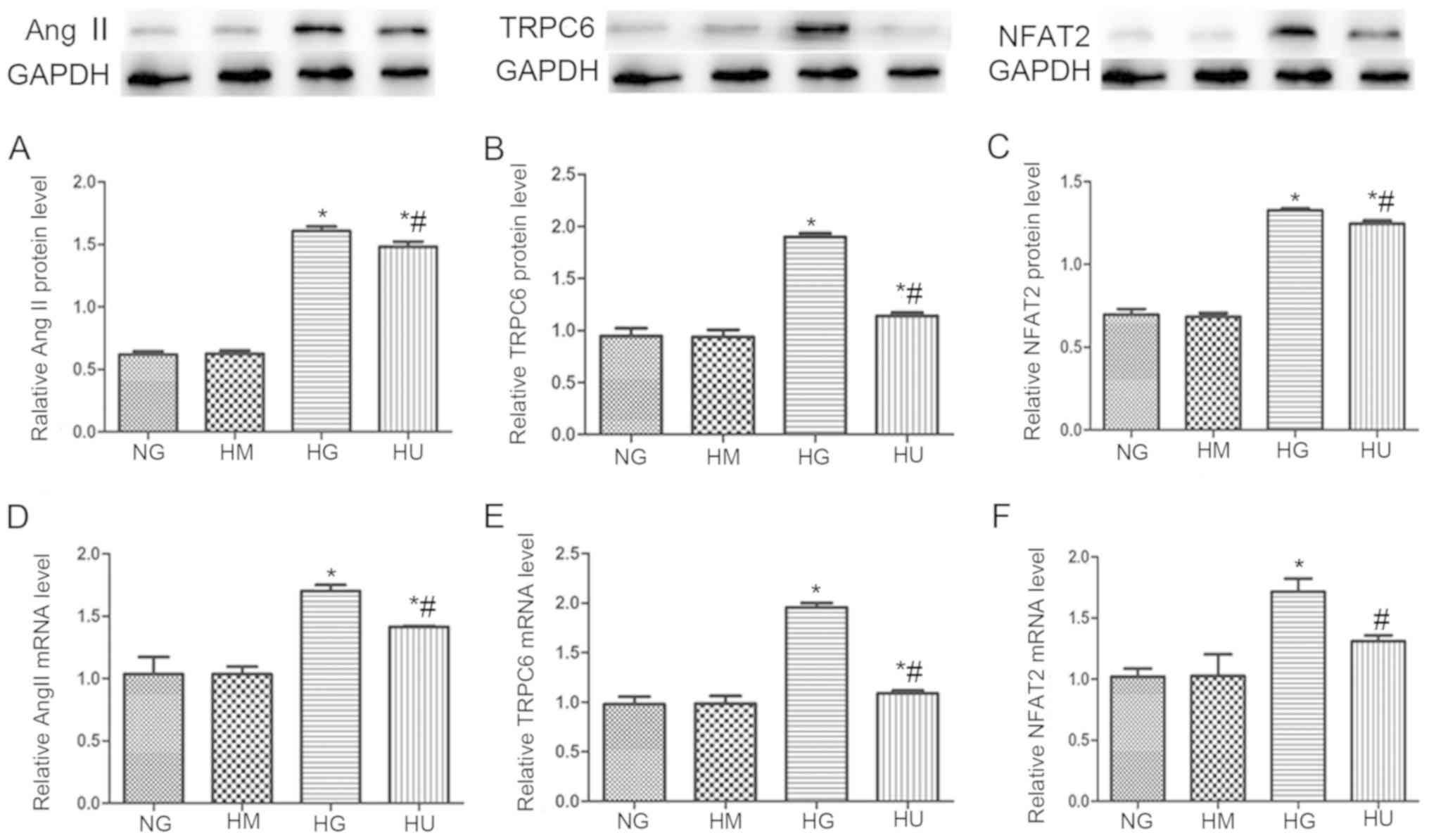|
1
|
Fioretto P, Mauer M, Brocco E, Velussi M,
Frigato F, Muollo B, Sambataro M, Abaterusso C, Baggio B, Crepaldi
G and Nosadini R: Patterns of renal injury in NIDDM patients with
microalbuminuria. Diabetologia. 39:1569–1576. 1996. View Article : Google Scholar : PubMed/NCBI
|
|
2
|
Osterby R, Gall MA, Schmitz A, Nielsen FS,
Nyberg G and Parving HH: Glomerular structure and function in
proteinuric type 2 (non-insulin-dependent) diabetic patients.
Diabetologia. 36:1064–1070. 1993. View Article : Google Scholar : PubMed/NCBI
|
|
3
|
White KE and Bilous RW: Type 2 diabetic
patients with nephropathy show structural-functional relationships
that are similar to type 1 disease. J Am Soc Nephrol. 11:1667–1673.
2000.PubMed/NCBI
|
|
4
|
Dalla Vestra M, Masiero A, Roiter AM,
Saller A, Crepaldi G and Fioretto P: Is podocyte injury relevant in
diabetic nephropathy? Studies in patients with type 2 diabetes.
Diabetes. 52:1031–1035. 2003. View Article : Google Scholar : PubMed/NCBI
|
|
5
|
White KE and Bilous RW; Diabiopsies Study
Group, : Structural alterations to the podocyte are related to
proteinuria in type 2 diabetic patients. Nephrol Dial Transplantat.
19:1437–1440. 2004. View Article : Google Scholar
|
|
6
|
Meyer TW, Bennett PH and Nelson RG:
Podocyte number predicts long-term urinary albumin excretion in
Pima Indians with Type II diabetes and microalbuminuria.
Diabetologia. 42:1341–1344. 1999. View Article : Google Scholar : PubMed/NCBI
|
|
7
|
Nakamura T, Ushiyama C, Osada S, Hara M,
Shimada N and Koide H: Pioglitazone reduces urinary podocyte
excretion in type 2 diabetes patients with microalbuminuria.
Metabolism. 50:1193–1196. 2001. View Article : Google Scholar : PubMed/NCBI
|
|
8
|
Pagtalunan ME, Miller PL, Jumping-Eagle S,
Nelson RG, Myers BD, Rennke HG, Coplon NS, Sun L and Meyer TW:
Podocyte loss and progressive glomerular injury in type II
diabetes. J Clin Invest. 99:342–348. 1997. View Article : Google Scholar : PubMed/NCBI
|
|
9
|
Estacion M, Sinkins WG, Jones SW,
Applegate MA and Schilling WP: Human TRPC6 expressed in HEK 293
cells forms non-selective cation channels with limited Ca2+
permeability. J Physiol. 572:359–377. 2006. View Article : Google Scholar : PubMed/NCBI
|
|
10
|
Möller CC, Wei C, Altintas MM, Li J, Greka
A, Ohse T, Pippin JW, Rastaldi MP, Wawersik S, Schiavi S, et al:
Induction of TRPC6 channel in acquired forms of proteinuric kidney
disease. J Am Soc Nephrol. 18:29–36. 2007. View Article : Google Scholar : PubMed/NCBI
|
|
11
|
Onohara N, Nishida M, Inoue R, Kobayashi
H, Sumimoto H, Sato Y, Mori Y, Nagao T and Kurose H: TRPC3 and
TRPC6 are essential for angiotensin II-induced cardiac hypertrophy.
EMBO J. 25:5305–5316. 2006. View Article : Google Scholar : PubMed/NCBI
|
|
12
|
Tai Y, Feng S, Ge R, Du W, Zhang X, He Z
and Wang Y: TRPC6 channels promote dendritic growth via the
CaMKIV-CREB pathway. J Cell Sci. 121:2301–2307. 2008. View Article : Google Scholar : PubMed/NCBI
|
|
13
|
Reiser J, Polu KR, Möller CC, Kenlan P,
Altintas MM, Wei C, Faul C, Herbert S, Villegas I, Avila-Casado C,
et al: TRPC6 is a glomerular slit diaphragm-associated channel
required for normal renal function. Nat Genet. 37:739–744. 2005.
View Article : Google Scholar : PubMed/NCBI
|
|
14
|
Winn MP, Conlon PJ, Lynn KL, Farrington
MK, Creazzo T, Hawkins AF, Daskalakis N, Kwan SY, Ebersviller S,
Burchette JL, et al: A mutation in the TRPC6 cation channel causes
familial focal segmental glomerulosclerosis. Science.
308:1801–1804. 2005. View Article : Google Scholar : PubMed/NCBI
|
|
15
|
Liu BC, Song X, Lu XY, Li DT, Eaton DC,
Shen BZ, Li XQ and Ma HP: High glucose induces podocyte apoptosis
by stimulating TRPC6 via elevation of reactive oxygen species.
Biochim Biophys Acta 1833. 1434–1442. 2013.
|
|
16
|
Sonneveld R, van der Vlag J, Baltissen MP,
Verkaart SA, Wetzels JF, Berden JH, Hoenderop JG and Nijenhuis T:
Glucose specifically regulates TRPC6 expression in the podocyte in
an AngII-dependent manner. Am J Pathol. 184:1715–1726. 2014.
View Article : Google Scholar : PubMed/NCBI
|
|
17
|
Brenner BM, Cooper ME, de Zeeuw D, Keane
WF, Mitch WE, Parving HH, Remuzzi G, Snapinn SM, Zhang Z and
Shahinfar S; RENAAL Study Investigators, : Effects of losartan on
renal and cardiovascular outcomes in patients with type 2 diabetes
and nephropathy. N Engl J Med. 345:861–869. 2001. View Article : Google Scholar : PubMed/NCBI
|
|
18
|
Singh R, Singh AK and Leehey DJ: A novel
mechanism for angiotensin II formation in streptozotocin-diabetic
rat glomeruli. Am J Physiol Renal Physiol. 288:F1183–F1190. 2005.
View Article : Google Scholar : PubMed/NCBI
|
|
19
|
Vidotti DB, Casarini DE, Cristovam PC,
Leite CA, Schor N and Boim MA: High glucose concentration
stimulates intracellular renin activity and angiotensin II
generation in rat mesangial cells. Am J Physiol Renal Physiol.
286:F1039–F1045. 2004. View Article : Google Scholar : PubMed/NCBI
|
|
20
|
Bansal SB, Sethi SK, Jha P, Duggal R and
Kher V: Remission of post-transplant focal segmental
glomerulosclerosis with angiotensin receptor blockers. Indian J
Nephrol. 27:154–156. 2017. View Article : Google Scholar : PubMed/NCBI
|
|
21
|
Hamaguchi A, Kim S, Wanibuchi H and Iwao
H: Angiotensin II and calcium blockers prevent glomerular
phenotypic changes in remnant kidney model. J Am Soc Nephrol.
7:687–693. 1996.PubMed/NCBI
|
|
22
|
Hayashi K, Sasamura H, Ishiguro K,
Sakamaki Y, Azegami T and Itoh H: Regression of glomerulosclerosis
in response to transient treatment with angiotensin II blockers is
attenuated by blockade of matrix metalloproteinase-2. Kidney Int.
78:69–78. 2010. View Article : Google Scholar : PubMed/NCBI
|
|
23
|
Suzuki K, Han GD, Miyauchi N, Hashimoto T,
Nakatsue T, Fujioka Y, Koike H, Shimizu F and Kawachi H:
Angiotensin II type 1 and type 2 receptors play opposite roles in
regulating the barrier function of kidney glomerular capillary
wall. Am J Pathol. 170:1841–1853. 2007. View Article : Google Scholar : PubMed/NCBI
|
|
24
|
Gagliardini E, Perico N, Rizzo P, Buelli
S, Longaretti L, Perico L, Tomasoni S, Zoja C, Macconi D, Morigi M,
et al: Angiotensin II contributes to diabetic renal dysfunction in
rodents and humans via Notch1/Snail pathway. Am J Pathol.
183:119–130. 2013. View Article : Google Scholar : PubMed/NCBI
|
|
25
|
Leehey DJ, Singh AK, Alavi N and Singh R:
Role of angiotensin II in diabetic nephropathy. Kidney Int. (Suppl
77):S93–S98. 2000. View Article : Google Scholar
|
|
26
|
Kuwahara K, Wang Y, McAnally J, Richardson
JA, Bassel-Duby R, Hill JA and Olson EN: TRPC6 fulfills a
calcineurin signaling circuit during pathologic cardiac remodeling.
J Clin Invest. 116:3114–3126. 2006. View
Article : Google Scholar : PubMed/NCBI
|
|
27
|
Saleh SN, Albert AP, Peppiatt CM and Large
WA: Angiotensin II activates two cation conductances with distinct
TRPC1 and TRPC6 channel properties in rabbit mesenteric artery
myocytes. J Physiol. 577:479–495. 2006. View Article : Google Scholar : PubMed/NCBI
|
|
28
|
Anderson M, Roshanravan H, Khine J and
Dryer SE: Angiotensin II activation of TRPC6 channels in rat
podocytes requires generation of reactive oxygen species. J Cell
Physiol. 229:434–442. 2014. View Article : Google Scholar : PubMed/NCBI
|
|
29
|
Chen S, He FF, Wang H, Fang Z, Shao N,
Tian XJ, Liu JS, Zhu ZH, Wang YM, Wang S, et al: Calcium entry via
TRPC6 mediates albumin overload-induced endoplasmic reticulum
stress and apoptosis in podocytes. Cell Calcium. 50:523–529. 2011.
View Article : Google Scholar : PubMed/NCBI
|
|
30
|
Zhang H, Ding J, Fan Q and Liu S: TRPC6
up-regulation in Ang II-induced podocyte apoptosis might result
from ERK activation and NF-kappaB translocation. Exp Biol Med
(Maywood). 234:1029–1036. 2009. View Article : Google Scholar : PubMed/NCBI
|
|
31
|
Schlöndorff J, Del Camino D, Carrasquillo
R, Lacey V and Pollak MR: TRPC6 mutations associated with focal
segmental glomerulosclerosis cause constitutive activation of
NFAT-dependent transcription. Am J Physiol Cell Physiol.
296:C558–C569. 2009. View Article : Google Scholar : PubMed/NCBI
|
|
32
|
Nijenhuis T, Sloan AJ, Hoenderop JG,
Flesche J, van Goor H, Kistler AD, Bakker M, Bindels RJ, de Boer
RA, Möller CC, et al: Angiotensin II contributes to podocyte injury
by increasing TRPC6 expression via an NFAT-mediated positive
feedback signaling pathway. Am J Pathol. 179:1719–1732. 2011.
View Article : Google Scholar : PubMed/NCBI
|
|
33
|
Danda RS, Habiba NM, Rincon-Choles H,
Bhandari BK, Barnes JL, Abboud HE and Pergola PE: Kidney
involvement in a nongenetic rat model of type 2 diabetes. Kidney
Int. 68:2562–2571. 2005. View Article : Google Scholar : PubMed/NCBI
|
|
34
|
Graham S, Ding M, Sours-Brothers S, Yorio
T, Ma JX and Ma R: Downregulation of TRPC6 protein expression by
high glucose, a possible mechanism for the impaired Ca2+ signaling
in glomerular mesangial cells in diabetes. Am J Physiol Renal
Physiol. 293:F1381–F1390. 2007. View Article : Google Scholar : PubMed/NCBI
|
|
35
|
Ilatovskaya DV, Palygin O, Levchenko V,
Endres BT and Staruschenko A: The role of angiotensin II in
glomerular volume dynamics and podocyte calcium handling. Sci Rep.
7:2992017. View Article : Google Scholar : PubMed/NCBI
|
|
36
|
Livak KJ and Schmittgen TD: Analysis of
relative gene expression data using real-time quantitative PCR and
the 2(-Delta Delta C(T)) method. Methods. 25:402–408. 2001.
View Article : Google Scholar : PubMed/NCBI
|
|
37
|
Su J, Li SJ, Chen ZH, Zeng CH, Zhou H, Li
LS and Liu ZH: Evaluation of podocyte lesion in patients with
diabetic nephropathy: Wilms' tumor-1 protein used as a podocyte
marker. Diabetes Res Clin Pract. 87:167–175. 2010. View Article : Google Scholar : PubMed/NCBI
|
|
38
|
Marshall SM: The podocyte: A potential
therapeutic target in diabetic nephropathy? Curr Pharm Des.
13:2713–2720. 2007. View Article : Google Scholar : PubMed/NCBI
|
|
39
|
Wolf G, Chen S and Ziyadeh FN: From the
periphery of the glomerular capillary wall toward the center of
disease: Podocyte injury comes of age in diabetic nephropathy.
Diabetes. 54:1626–1634. 2005. View Article : Google Scholar : PubMed/NCBI
|
|
40
|
Menè P, Punzo G and Pirozzi N: TRP
channels as therapeutic targets in kidney disease and hypertension.
Curr Top Med Chem. 13:386–397. 2013. View Article : Google Scholar : PubMed/NCBI
|
|
41
|
Thilo F, Liu Y, Loddenkemper C, Schuelein
R, Schmidt A, Yan Z, Zhu Z, Zakrzewicz A, Gollasch M and Tepel M:
VEGF regulates TRPC6 channels in podocytes. Nephrol Dial
Transplant. 27:921–929. 2012. View Article : Google Scholar : PubMed/NCBI
|
|
42
|
Weber EW, Han F, Tauseef M, Birnbaumer L,
Mehta D and Muller WA: TRPC6 is the endothelial calcium channel
that regulates leukocyte transendothelial migration during the
inflammatory response. J Exp Med. 212:1883–1899. 2015. View Article : Google Scholar : PubMed/NCBI
|
|
43
|
Durvasula RV and Shankland SJ: Activation
of a local renin angiotensin system in podocytes by glucose. Am J
Physiol Renal Physiol. 294:F830–F839. 2008. View Article : Google Scholar : PubMed/NCBI
|
|
44
|
Yoo TH, Li JJ, Kim JJ, Jung DS, Kwak SJ,
Ryu DR, Choi HY, Kim JS, Kim HJ, Han SH, et al: Activation of the
renin-angiotensin system within podocytes in diabetes. Kidney Int.
71:1019–1027. 2007. View Article : Google Scholar : PubMed/NCBI
|
|
45
|
Gabriel CH, Gross F, Karl M, Stephanowitz
H, Hennig AF, Weber M, Gryzik S, Bachmann I, Hecklau K, Wienands J,
et al: Identification of novel nuclear factor of activated T cell
(NFAT)-associated proteins in T cells. J Biol Chem.
291:24172–24187. 2016. View Article : Google Scholar : PubMed/NCBI
|
|
46
|
Pachulec E, Neitzke-Montinelli V and Viola
JP: NFAT2 regulates generation of innate-like CD8+ T
lymphocytes and CD8+ T lymphocytes responses. Front
Immunol. 7:4112016. View Article : Google Scholar : PubMed/NCBI
|
|
47
|
Yang H, Zhao B, Liao C, Zhang R, Meng K,
Xu J and Jiao J: High glucose-induced apoptosis in cultured
podocytes involves TRPC6-dependent calcium entry via the RhoA/ROCK
pathway. Biochem Biophys Res Commun. 434:394–400. 2013. View Article : Google Scholar : PubMed/NCBI
|
|
48
|
Li Z, Xu J, Xu P, Liu S and Yang Z:
Wnt/β-catenin signalling pathway mediates high glucose induced cell
injury through activation of TRPC6 in podocytes. Cell Prolif.
46:76–85. 2013. View Article : Google Scholar : PubMed/NCBI
|
|
49
|
Qiu G and Ji Z: AngII-induced glomerular
mesangial cell proliferation inhibited by losartan via changes in
intracellular calcium ion concentration. Clin Exp Med. 14:169–176.
2014. View Article : Google Scholar : PubMed/NCBI
|
|
50
|
Lawrence MC, Bhatt HS and Easom RA: NFAT
regulates insulin gene promoter activity in response to synergistic
pathways induced by glucose and glucagon-like peptide-1. Diabetes.
51:691–698. 2002. View Article : Google Scholar : PubMed/NCBI
|
|
51
|
Nilsson J, Nilsson LM, Chen YW, Molkentin
JD, Erlinge D and Gomez MF: High glucose activates nuclear factor
of activated T cells in native vascular smooth muscle. Arterioscler
Thromb Vasc Biol. 26:794–800. 2006. View Article : Google Scholar : PubMed/NCBI
|
|
52
|
Li R, Zhang L, Shi W, Zhang B, Liang X,
Liu S and Wang W: NFAT2 mediates high glucose-induced glomerular
podocyte apoptosis through increased Bax expression. Exp Cell Res.
319:992–1000. 2013. View Article : Google Scholar : PubMed/NCBI
|
|
53
|
Wang L, Chang JH, Paik SY, Tang Y, Eisner
W and Spurney RF: Calcineurin (CN) activation promotes apoptosis of
glomerular podocytes both in vitro and in vivo. Mol Endocrinol.
25:1376–1386. 2011. View Article : Google Scholar : PubMed/NCBI
|
|
54
|
Zhang L, Li R, Shi W, Liang X, Liu S, Ye
Z, Yu C, Chen Y, Zhang B, Wang W, et al: NFAT2 inhibitor
ameliorates diabetic nephropathy and podocyte injury in db/db mice.
Br J Pharmacol. 170:426–439. 2013. View Article : Google Scholar : PubMed/NCBI
|



